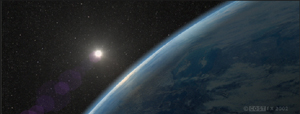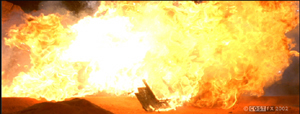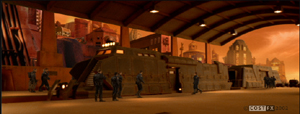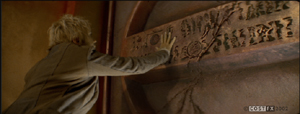|
Lance
Wilhoite was the producer at KEYT in Santa Barbara when his life took
an unexpected turn. He and his wife were going through a divorce and he asked
the owners if he could switch to a part time schedule to sort things out for
a brief time. When KEYT denied his request, John Grower
of Santa Barbara Studios quickly acquired the triple Emmy award winning
producer. Over his 12 years at the TV station, Wilhoite had developed
a keen sense for creating stunning visuals while returning a significant
portion of the production budget back to management. Grower was anxious
to put Wilhoite’s creative skills to work streamlining the company’s entire
visual effects production process. Wilhoite began with such films as "Star
Trek: Insurrection", “An American Werewolf in Paris”, "Spawn"
, “Paulie”, “Supernova”, “Roadtrip”, and for the episodic, "Star
Trek: Voyager."
When veteran director John Carpenter asked Wilhoite to be the Visual
Effects Superviser for the challenging
effects of “Ghosts of Mars”, he had no idea Wilhoite would return nearly
half of the $4 million budgets proposed by Industrial Light and Magic
and Digital Domain.
At the helm of his new company, CostFX Supervision, Wilhoite showed veteran
director John Carpenter a few new tricks, and learned some new tricks
himself. He talked to VFXPro about his experience of creating visual effects
on a limited budget.
| |

|
Sunrise From Space
5.3 MB QuickTime 5 Movie
|

|
Can you start off by telling me how you got involved with the project?
Carpenter had been teaching a science fiction cinema class here at UCSB.
He was very into Star Trek, so I invited him
to our shop. All of us at Santa Barbara Studios were very excited to meet
him. He told me about “Ghost’s of Mars” and that it called for lots of
effects. He had initially gone to his old friends at ILM and Digital Domain.
They reviewed the storyboards and gave him estimates of $4 million. John
Carpenter saw the great work of the team I assembled and asked if I could
save him 20%. I showed him how we would get the quality of visuals he
was seeking for $2 million and he hired me as the Visual Effects Supervisor
| |

|
Train Explodes
7.3 MB QuickTime 3 Movie
|

|
Why did you want to work for Carpenter?
He simply commands great respect in the industry. He is truly one of the
masters of our time and it was a great honor to work for him. We all knew
he expected a lot and it was my job to get his vision realized on film.
And I got great satisfaction knowing that the money I saved him really
went a long way to help other areas of the production that really needed
it.
And the film was shot primarily in Los Angeles?
Actually, New Mexico was the site for most of it. We turned a gypsum mine
into a Martian landscape with thousands of gallons of red food coloring.
We shot from sunset to sunrise for two months straight.
It’s kind of a Western on Mars. There's a small mining
town outside of the main city. They still use shotguns. No lasers or hi
tech weapons. It’s very low tech by design. John wanted a retro feel and
it really made for an interesting picture… classic Carpenter.
| |

|
Chryse Train Station
7.7 MB QuickTime 3 Movie
|

|
One of the greatest challenges he offered me was the opening sequence.
John wanted to see a train speeding through a blinding dust storm on the
desolate Martian surface. A tall order for a single shot. But he wanted
the sequence to last for the entire opening credits! This would of course
be done in miniature but the old rule of thumb was that models are most
believable in short shots. The first challenge was to create 21 different
camera moves from one table top miniature set. I had the set mocked up
in pre-vis so I could work out the shot choreography well before the actual
production. We wrote a custom piece of software to better translate the
Maya pre-vis data to the motion control rig so there was very little guesswork.
The airborn particulate used to create the dust storms
was presented to me as a rather large cost center. We needed a lot of
it so I researched alternative materials and discovered finely ground
walnut shells were less than half the cost of the old standard. Our tests
of both materials revealed that the walnut shells actually read better
on film. Carpenter was ultimately very happy with the look of the entire
sequence.
| |

|
Dissolving Wall
7.7 MB QuickTime 3 Movie |

|
What I tried to do is gather more information on the set. In the old days
we would take measurements and plot out lighting grids. I took it one
step further and got approval of key points of the shots on film from
John right there on the set.
For example, in the film miners throw these razor disks -- they are like
mining discs that are very sharp. Thrown like Frisbees, they had to cut
off arms and heads. These would of course be CG. But in addition to the
normal data I went out there and held a practical spear or razor disc
in various spots and got Carpenter to look through the lens and give me
buy-off on the trajectory path right there on the set. We were able to
get that done quickly so that when we got back to the computers, there
was almost nothing left to figure out about the shot. That could easily
have been a few days worth of budget busting work, figuring out different
scenarios of motion.
|



